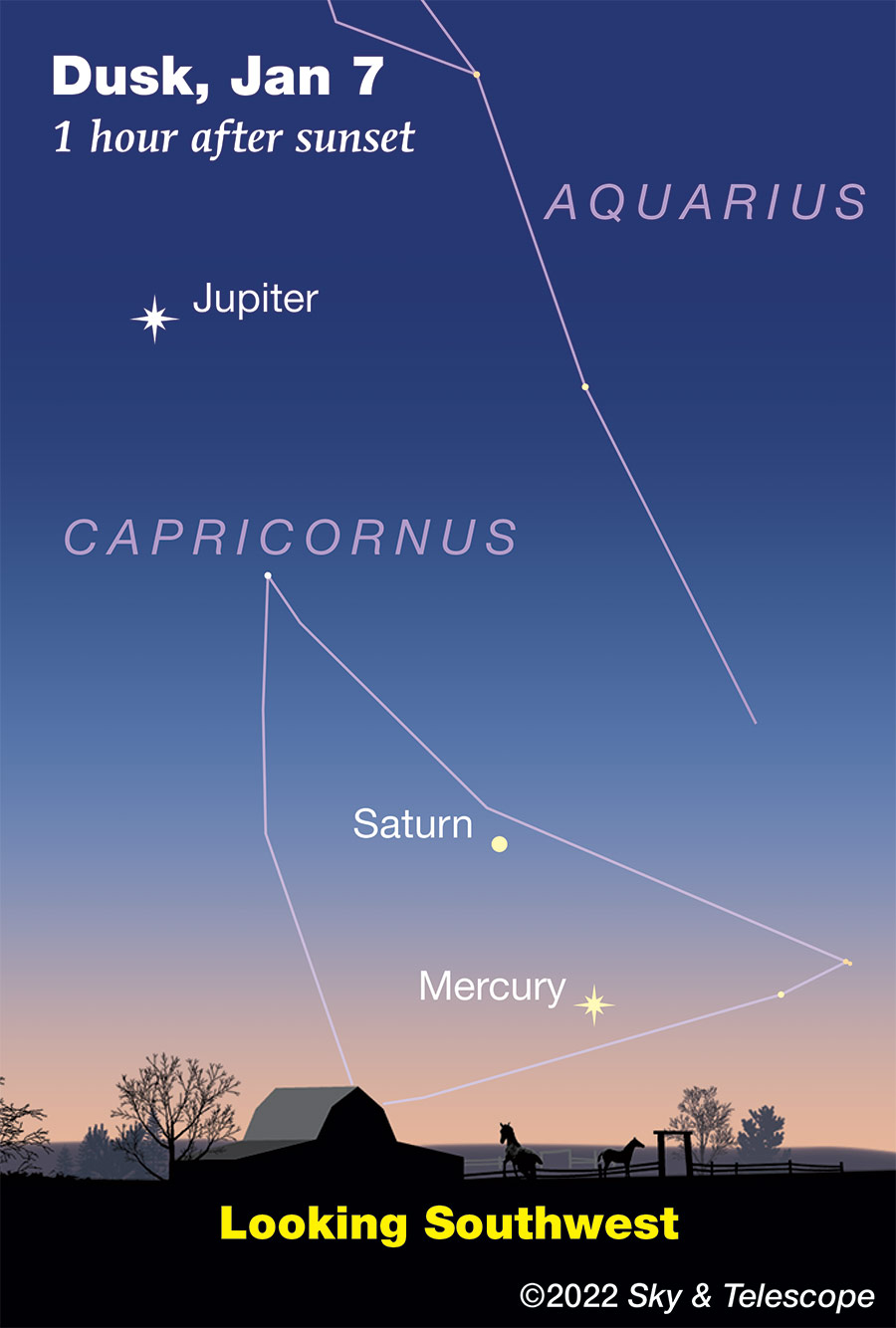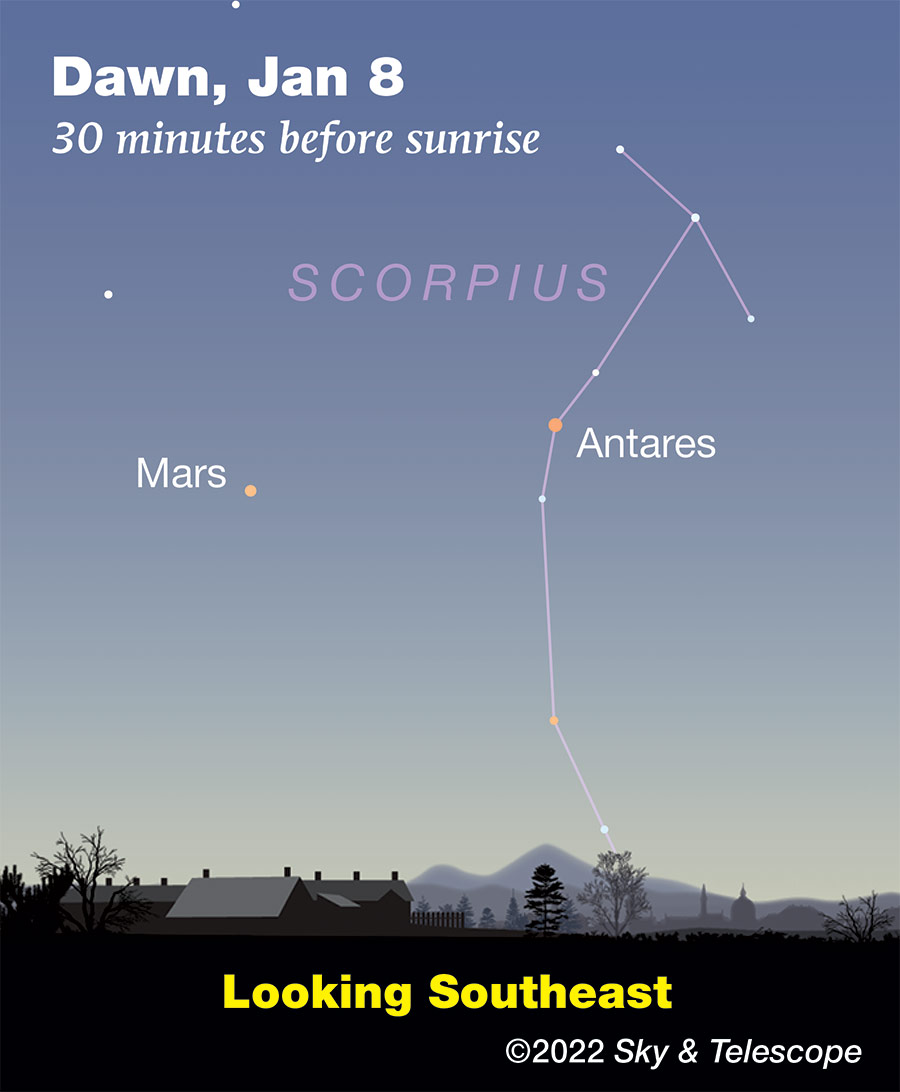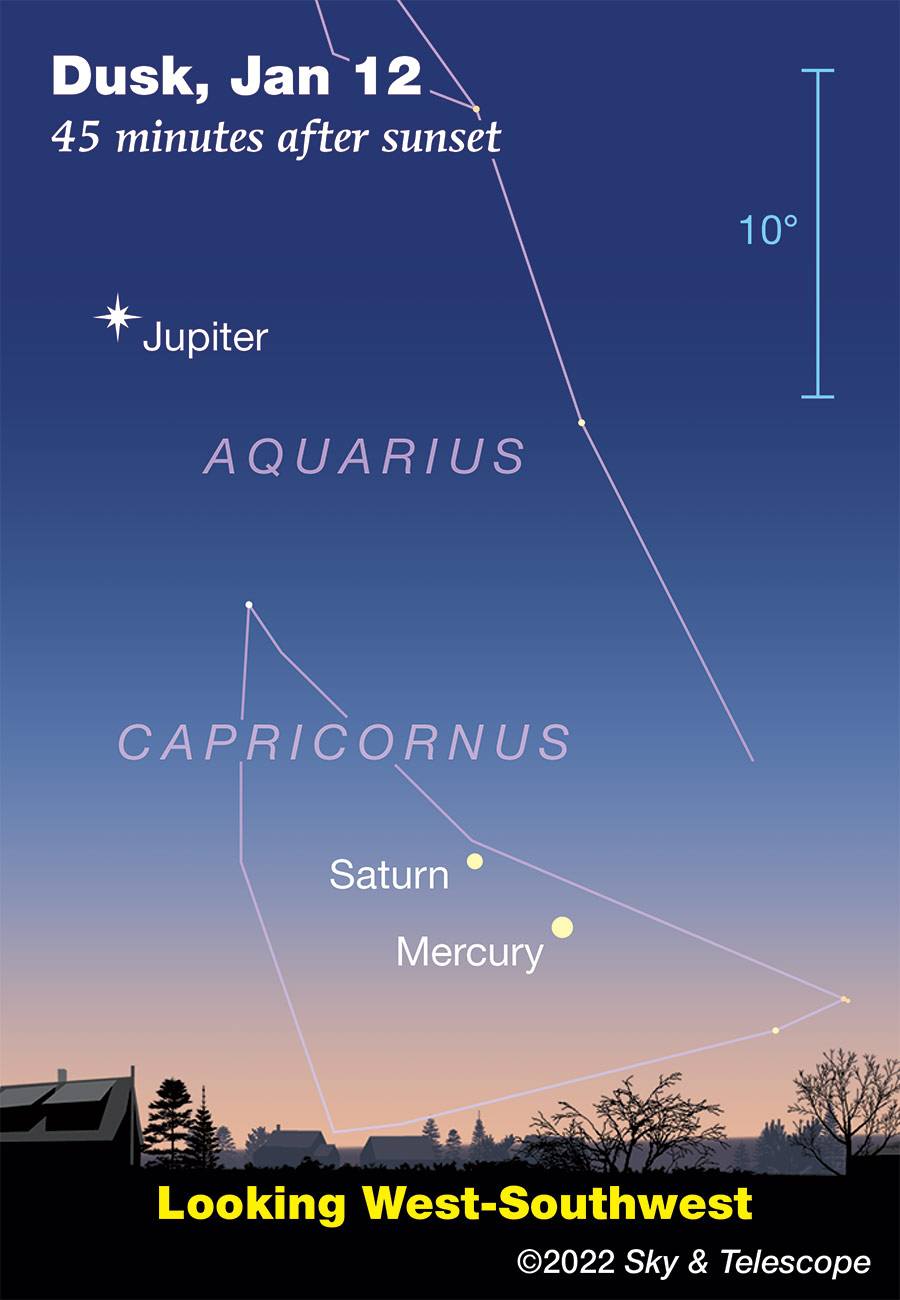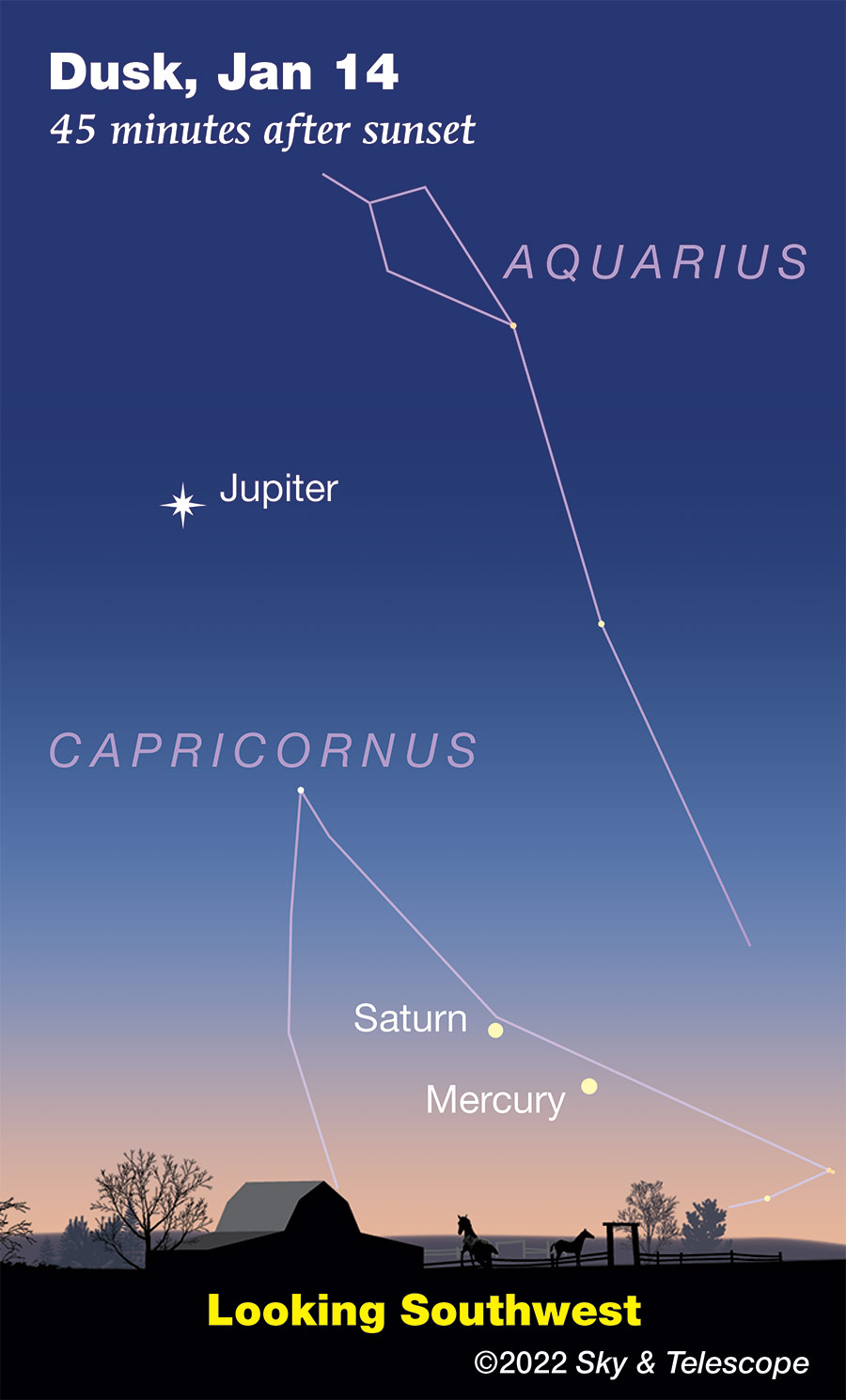FRIDAY, JANUARY 7
■ Jupiter continues to shine high and bright in the southwest at dusk this week. Way down to its lower right Saturn is sinking toward the sunset, while Mercury approaches Saturn day by day from underneath. See the scenes below.
Today Mercury is at greatest elongation, 19° east of the Sun.


SATURDAY, JANUARY 8
■ After dinnertime, the enormous Andromeda-Pegasus complex runs from near the zenith way down toward the western horizon.
Barely west of the zenith, spot Andromeda's high foot: 2nd-magnitude Gamma Andromedae (Almach), slightly orange. Andromeda is standing on her head. About halfway down from the zenith to the west horizon is the Great Square of Pegasus, balancing on one corner. Andromeda's head is its top corner. From the bottom corner run the stars outlining Pegasus's neck and head, ending at his nose: 2nd-magnitude Enif, due west. It too is slightly orange.
SUNDAY, JANUARY 9
■ First-quarter Moon; exact at 1:11 p.m. Eastern Standard Time. Come evening the Moon shines high in dim Pisces, some 10° west of 4th-magnitude al-Rescha, the Knot of the two fishes' cords.
■ Very high in the southwest some three fists above Jupiter, the Great Square of Pegasus remains tipped on one corner. The Square's horizontal diagonal points left nearly at the Moon (by about its own length).
MONDAY, JANUARY 10
■ The big Northern Cross in Cygnus, topped by Deneb, is nearly upright in the west-northwest right after full darkness falls. Another hour or so and it's standing on the horizon. How straight up it stands depends on your latitude.
TUESDAY, JANUARY 11
■ The Gemini twins lie on their sides these January evenings, left of Orion. Their head stars, Castor and Pollux, are farthest from Orion, one over the other. (Castor is the top one, slightly the fainter of the two.) The Castor figure's feet are just left of Orion's very dim, upraised Club.
WEDNESDAY, JANUARY 12
■ Low in the sunset, Mercury has now faded to be less than twice as bright as Saturn; they're magnitudes +0.1 and +0.7, respectively. See below. Mercury will be further dimmed with respect to Saturn by the thicker atmospheric extinction at its lower altitude.

THURSDAY, JANUARY 13
■ Auriga the Charioteer rides high these evenings astride the Milky Way, awaiting your eyes and scope. Use Ken Hewitt-White's "Suburban Stargazer" guide with its chart of telescopic targets in central Auriga (working out from the Leaping Minnow and False Minnow asterisms) in the January Sky & Telescope, page 54.
FRIDAY, JANUARY 14
■ Zero-magnitude Capella high overhead, and equally bright Rigel in Orion's foot, have almost the same right ascension. This means they cross your sky’s meridian at almost exactly the same time: around 9 or 10 p.m. now, depending on how far east or west you live in your time zone. So whenever Capella passes its very highest, Rigel always marks true south over your landscape, and vice versa.
Capella goes exactly through your zenith if you're at latitude 46° north: Portland, Oregon; Montreal; central France.

SATURDAY, JANUARY 15
■ Here it is the coldest very bottom of the year, but the Summer Star, Vega, is still barely hanging in. Look for it twinkling over the northwest horizon during and shortly after nightfall. The farther north you are the higher it will be. If you're as far south as Florida, it's already gone.
This Week's Planet Roundup
Mercury is low in the west-southwest in twilight, with Saturn near it. Watch their changing configuration, as shown above. Mercury is fading; this week it diminishes from magnitude –0.5 to +0.6.
Venus is out of sight. It goes through solar conjunction, passing 5° north of the Sun, on January 8th. Next week it will begin emerging low in the dawn.
Mars, in the feet of Ophiuchus, is low in the southeast in early dawn. It's far and faint at magnitude +1.5. To its right or upper right, Mars-colored Antares twinkles a little brighter at magnitude +1.0. Mars and Antares are nearly 10° apart on the morning of January 8th, widening to 13° by the 15th.
Mars is on the far side of its orbit from us, so in a telescope it's just a tiny shimmering blob 4 arcseconds wide.
Jupiter, magnitude –2.1 in Aquarius, shines brightly in the southwest at dusk. Spot Fomalhaut, magnitude +1.2, two fists at arm's length to Jupiter's lower left.
Saturn, magnitude +0.7 in Capricornus, is that same distance to Jupiter's lower right.
Uranus (magnitude 5.7, in Aries) is very high in the south in early evening. See Bob King's story and finder chart.
Neptune (magnitude 7.9, in Aquarius) is much lower in the southwest after dark. It adds an invisible (to the naked-eye) planet to the Saturn-Jupiter line, 20° upper left of Jupiter.
All descriptions that relate to your horizon — including the words up, down, right, and left — are written for the world's mid-northern latitudes. Descriptions and graphics that also depend on longitude (mainly Moon positions) are for North America.
Eastern Standard Time, EST, is Universal Time (also called UT, UTC, GMT, or Z time) minus 5 hours.
Want to become a better astronomer? Learn your way around the constellations. They're the key to locating everything fainter and deeper to hunt with binoculars or a telescope.
This is an outdoor nature hobby. For an easy-to-use constellation guide covering the whole evening sky, use the big monthly map in the center of each issue of Sky & Telescope, published by the American Astronomical Society.
Once you get a telescope, to put it to good use you'll need a detailed, large-scale sky atlas (set of charts). The basic standard is the Pocket Sky Atlas (in either the original or Jumbo Edition), which shows stars to magnitude 7.6.

Next up is the larger and deeper Sky Atlas 2000.0, plotting stars to magnitude 8.5; nearly three times as many. The next up, once you know your way around, are the even larger Interstellarum atlas (stars to magnitude 9.5) or Uranometria 2000.0 (stars to magnitude 9.75). And be sure to read How to Use a Star Chart with a Telescope.
You'll also want a good deep-sky guidebook. An impressive one is the big Night Sky Observer's Guide set (2+ volumes) by Kepple and Sanner.
Can a computerized telescope replace charts? Not for beginners, I don't think, and not on mounts and tripods that are less than top-quality mechanically, meaning heavy and expensive. And as Terence Dickinson and Alan Dyer say in their Backyard Astronomer's Guide, "A full appreciation of the universe cannot come without developing the skills to find things in the sky and understanding how the sky works. This knowledge comes only by spending time under the stars with star maps in hand."
![]() Audio sky tour. Out under the evening sky with your
Audio sky tour. Out under the evening sky with your
earbuds in place, listen to Kelly Beatty's monthly
podcast tour of the heavens above. It's free.
"The dangers of not thinking clearly are much greater now than ever before. It's not that there's something new in our way of thinking, it's that credulous and confused thinking can be much more lethal in ways it was never before."
— Carl Sagan, 1996
"Facts are stubborn things."
— John Adams, 1770
 8
8









Comments
Rod
January 7, 2022 at 11:53 am
I was able to enjoy some solar observing this morning. [Observed 0945-1045 EST/1445-1545 UT. Spaceweather.com reports, "Sunspot AR2924 has quadrupled in size during the past 48 hours and could soon pose a threat for Earth-directed solar flares. Credit: SDO/HMI". Using my 90-mm refractor with 25-mm plossl eyepiece, #12 yellow filter and glass white light solar filter, I could easily see AR2925 with plage area and AR2924. Two dark cores are larger than earth size. Telescope view at 40x, true FOV ~ 78 arcminute, ~ 7.5 arcsecond resolution. On the Sun about 5349 km diameter size. Earth size ~ 18 arcsecond on the Sun at 0.9833 au (Stellarium 0.21.3 and Starry Night Pro Plus 8 report 0.983 or so au). Sun's angular size ~ 32.53 arcminutes. Stellarium 0.21.3 shows 32.51 arcminute angular size for the Sun. Light blowing snow all around. An additional 3-5 inches of snow fell early this morning. Temperature -2C, winds NW at 15 knots, gusting 20 knots while I viewed. Cumulus clouds blew by the eyepiece FOV while I observed. NWS reports winds aloft at EMI station, 3000-9000 feet, some 300/30 knots so the clouds moved by quickly. An enjoyable view of the winter Sun in Sagittarius. Aphelion Day is 04-Jul-2022 so the Sun's angular size in telescope views will slowly get smaller as we approach the summer solstice and Aphelion Day. Perihelion Day was 04-Jan-2022.]
Some thawing and refreezing created various icy areas covered with snow in the fields and pastures, so I am very careful with the telescopes 🙂
You must be logged in to post a comment.
Rod
January 8, 2022 at 9:54 pm
I did some winter stargazing tonight, very enjoyable. [Observed 1830-2000 EST/2330-0100 UT. First Quarter Moon 09-Jan-2022 1811 UT. I was out this winter evening enjoying some lunar views using the 90-mm refractor telescope with 14-mm eyepiece, 71x views. True FOV about 1-degree. Excellent views of Aristoteles, Eudoxus, and Maurolycus areas and along the terminator line. Earthshine lovely. The star TYC 4673-5-1 close to 20 arcminute angular separation from the Moon’s limb. SIMBAD portal shows it is about 8.57 magnitude and about 1050 LY distance, stellar parallax 3.1065 mas. The Moon close to 386600 km. Virtual Moon Atlas shows the Moon's angular size 30.91 arcminutes. Other targets I enjoyed viewing tonight, M37, M36 in Auriga. M35 and NGC 2158 open clusters in Gemini. Both open clusters visible in same FOV but NGC 2158, faint. The 10-inch Newtonian does an excellent job here. M35 quite lovely in the 90-mm refractor telescope view. Another favorite winter target, Rigel as a double star. The views were tack sharp and the companion easy to see. Rigel is about 264 pc and 9.5 arcsecond separation so the double is about 2508 AU apart. M42 was a great view tonight. So much nebulosity and 4 stars easily visible in the Trapezium. The large nebulous arc very distinct and easy to see. Temperature -6C and coming back inside, the wood burning stove running felt very good.
You must be logged in to post a comment.
mary beth
January 9, 2022 at 10:54 pm
Nice reports Rod. Love your first quarter moon description. I’d love to someday see Rigel as a double star. How did you determine the dates of aphelion and perihelion? is there a website with this information or did you use some type of astronomy app?
You must be logged in to post a comment.
Rod
January 10, 2022 at 7:03 am
mary beth, no astronomy app used 🙂 I receive Sky & Telescope monthly magazine, the details provided there. The January issue has the Skygazer's Almanac for 2022 showing events in the evening and morning sky set to 40 degrees N latitude. Perihelion and Aphelion dates from that source. This morning near 0615 EST/1115 UT at my location, I could see bright Vega up, Polaris, Ursa Minor, Ursa Major, and Cephus with cirrus blowing over. Temperature -1C and getting colder again here with NW winds 15 knots or more. Perhaps another lunar observation night this evening along with some other bright stars and clusters is on my list of things to do 🙂 Wood burning stove will be running too 🙂
You must be logged in to post a comment.
mary beth
January 10, 2022 at 3:54 pm
Thanks. You got me curious, I went to timeanddate.com and read this interesting information:
Due to variations in the eccentricity of the Earth's orbit, the dates when the Earth reaches its perihelion or aphelion are not fixed. In 1246, the December Solstice was on the same day as the Earth reached its perihelion. Since then, the perihelion and aphelion dates have drifted by a day every 58 years. In the short-term, the dates can vary up to two days from one year to another.
Mathematicians and astronomers estimate that in 6430, over 4000 years from now, the perihelion will coincide with the March equinox.
You must be logged in to post a comment.
Sean Walker
January 10, 2022 at 3:50 pm
Like I do every time it's clear on the day or two nearest the planet's inferior conjunction with the Sun, I observed Venus on Saturday at about 11:25AM EST. This year it was quite easy and safe to spot the planet. It passed a bit more than 4 degrees due north of the Sun (4.48 degrees at the time I viewed it), so it was just a matter of blocking the Sun while sweeping the sky north of it until I came across the planet.
Setting my 92mm refractor up in the shadow of my house did the trick- there was no chance I could accidentally point my scope at the Sun. Additionally, I set the focus on my scope/eyepiece combination two nights previous when observing the Moon, ands simply left the scope set up and ready to bring out for this observing opportunity.
The preparation paid off nicely, as it only took maybe 10 seconds before the planet swung through the FOV in my 2" 25mm EP. Seeing was pretty rough, having just had a snowstorm the day before, and it was windy and cold. But Venus appeared like a large crescent, almost an annulus that never quite connected 100% around the planet due to the poor seeing, but it was still fun and satisfying to observe.
You must be logged in to post a comment.
Rod
January 11, 2022 at 7:49 am
Sean Walker, good report. Glad to see you use a 92-mm refractor with 2-inch focuser. My 90-mm refractor is 1.25-inch focuser mounted on a Vixen Porta II Altazimuth mount, dovetail plate with tube rings. My 10-inch Newtonian uses 2-inch and 1.25-inch eyepieces and is Dob mount system with guide knob. No automation for me 🙂
You must be logged in to post a comment.
Rod
January 11, 2022 at 11:46 am
I did some solar observing this morning. [Observed 1000-1100 EST/1500-1600 UT. Spaceweather.com reports, "All of these sunspots have stable magnetic fields that pose little threat for strong flares. Credit: SDO/HMI", AR2924, AR2925, and AR2927. I viewed this morning using glass white light solar filter. 90-mm refractor, 25-mm plossl at 40x using #12 yellow filter gave very good views. I also used 40-mm plossl without yellow filter at 25x. This gave excellent results. One small sunspot group visible in northern region (upper right corner) shown on spaceweather.com but no active region number presented, easily visible. AR2927 disclosed much plage around the region. The scale shows AR2924 and AR2925 contain sunspots as large or larger than Earth size, https://sohowww.nascom.nasa.gov/data/synoptic/sunspots_earth/mdi_sunspots_1024.jpg Temperature outside -6C and winds N at 10 knots. An enjoyable winter solar observation. Around the solar limb, thermal currents visible because the solar limb showed some slight waviness when I viewed this morning. Sky & Telescope published this report on safe solar observing, https://skyandtelescope.org/observing/observing-the-sun/ "There are two ways to look at the Sun safely: by direct viewing, with a proper filter over the front of the telescope, or by projecting the Sun’s image onto a piece of paper." I use the direct method using a safe, approved glass white solar filter that fits over the front of the telescope and blocks most of the light from entering. At 25x views today, the telescope resolved to about 12 arcseconds on the Sun. Earth size about 18 arcseconds on the Sun.]
You must be logged in to post a comment.
You must be logged in to post a comment.